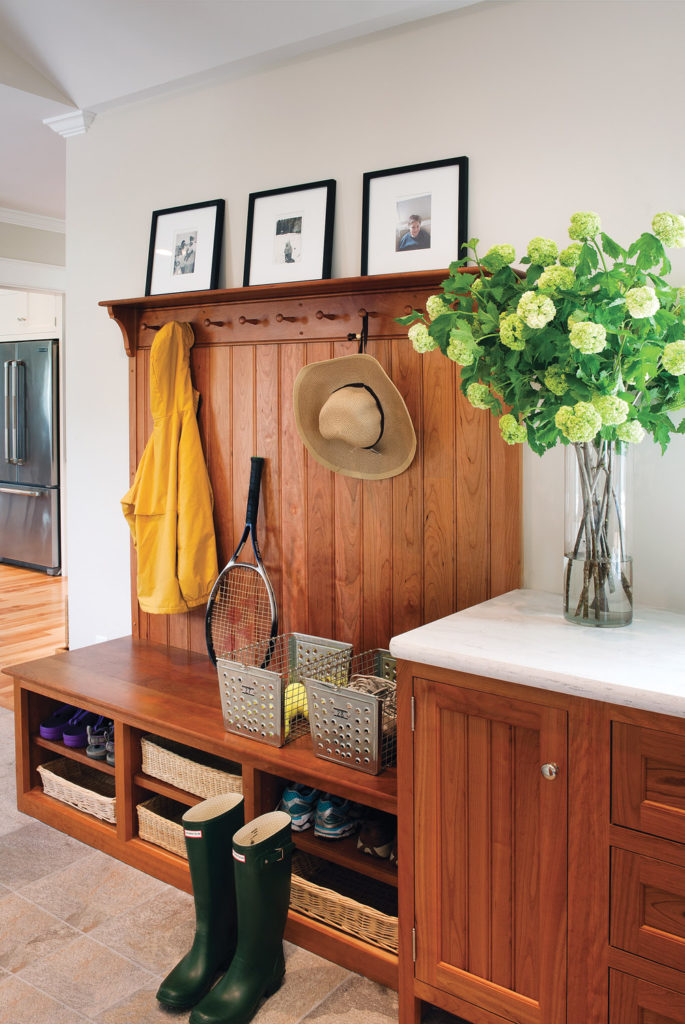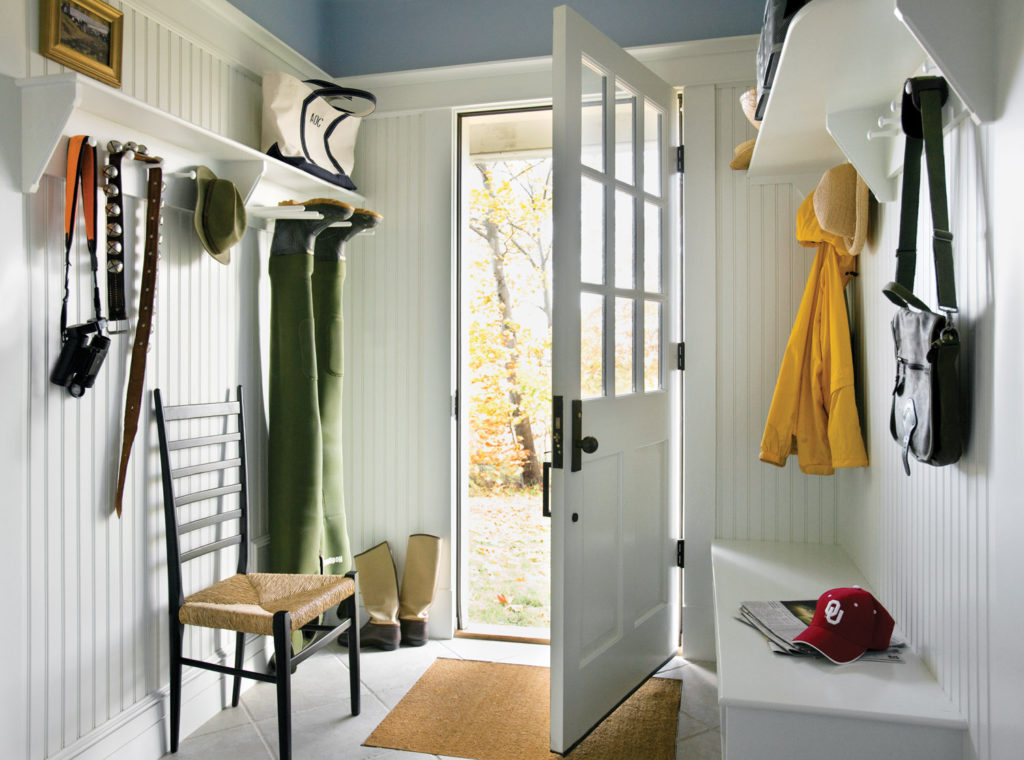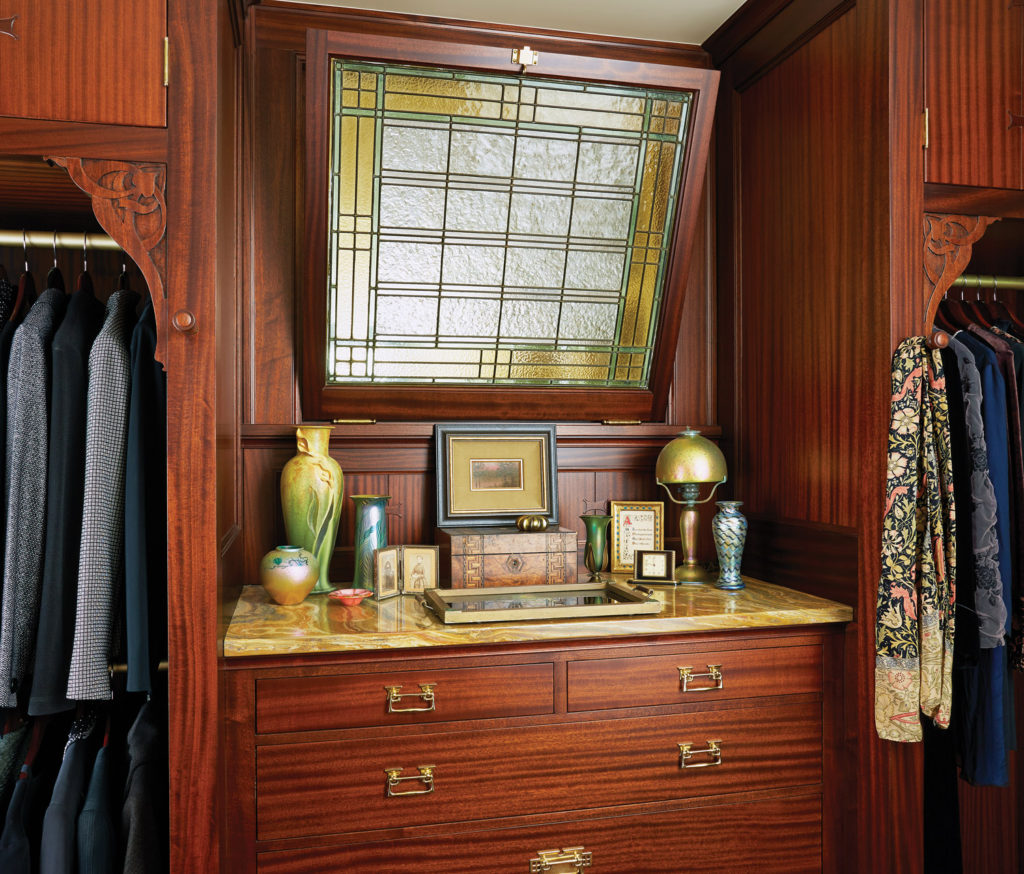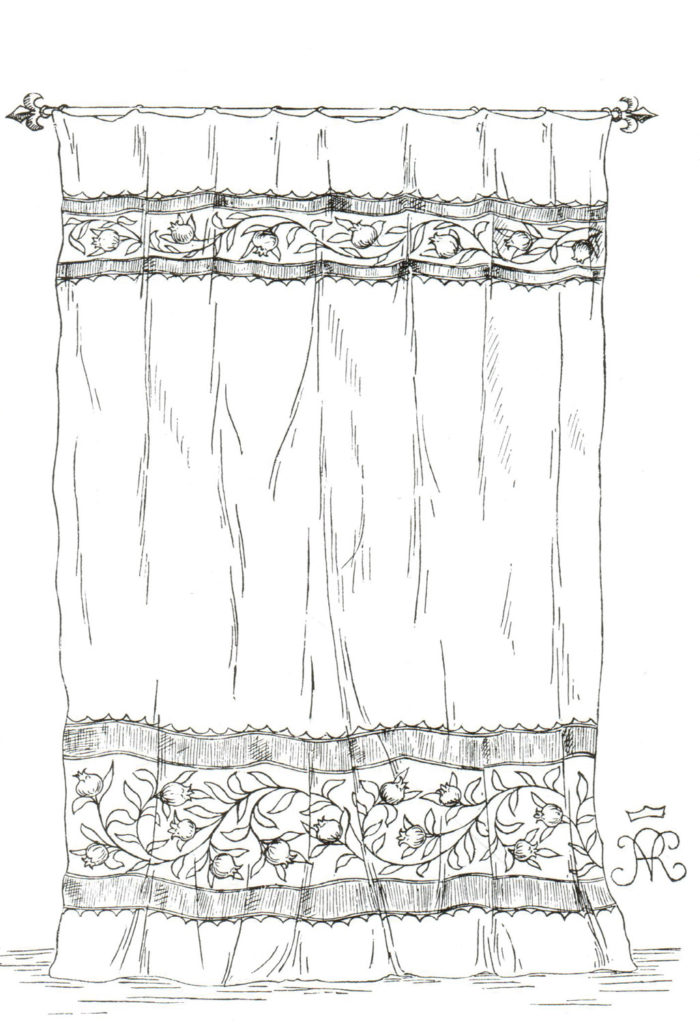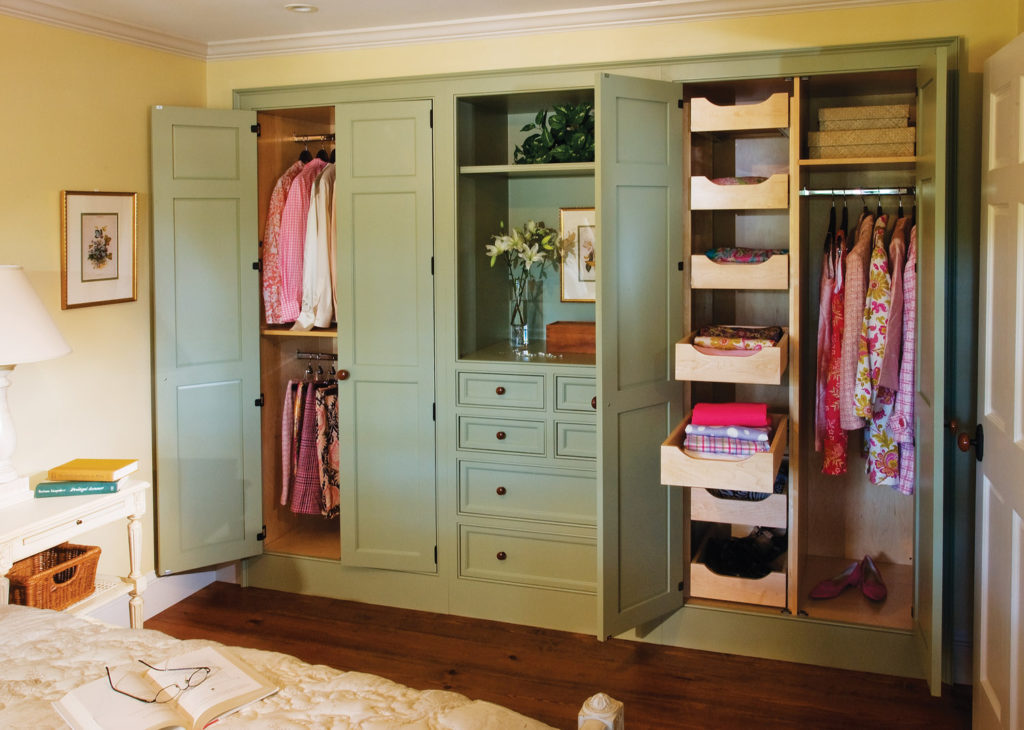Like old-fashioned pantries, the modern mudroom is essentially a large closet for specialized storage. If yours is an old house, you can borrow storage ideas and details from the past to inform the design of mudrooms and closets. Traditional options look to such precedents as farmhouse boot rooms, freestanding cabinets, built-in cupboards and benches, and original kitchens and pantries.
Closets are rare in old houses, but the “mud area” has long been a necessity in rural areas. Often just a vestibule or back hall off the kitchen, the mudroom was a buffer between the dirt of outdoors and indoor cleanliness, a place to leave boots and umbrellas; it may have had a utility sink. In houses built since the 1980s, the mudroom is a dedicated space, often located between the garage and the kitchen.
In a house on Boston’s North Shore, a foyer becomes a small but cheerful mudroom offering a few hooks and landing areas. Eric Roth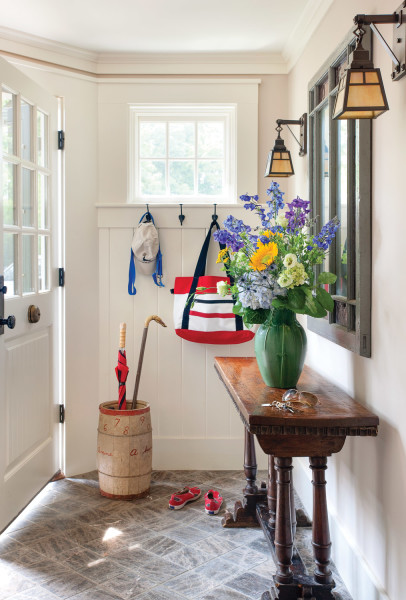
Mudrooms, boot rooms, and back halls I first heard the word “mudroom” when I moved to New England. It’s so familiar now, but I remember once finding the word indelicate. In my grandparents’ day, the out-of-sight entry was called the back hall. No matter whether it was off the front door or behind the kitchen, that’s what it was called, and it wasn’t for public view. This is where boots came off, laundry was sorted (and often washed), flowers were cut, and where folded paper bags and the big roasting pan were stored. The only givens were a tough floor—brick or linoleum—and some shelves or bins. All very utilitarian.
At an early-19th-century house in Vermont, the simple mudroom has a peg rail that’s now augmented by a closed closet— no custom cubbies here. The woodwork is butternut. Carolyn Bates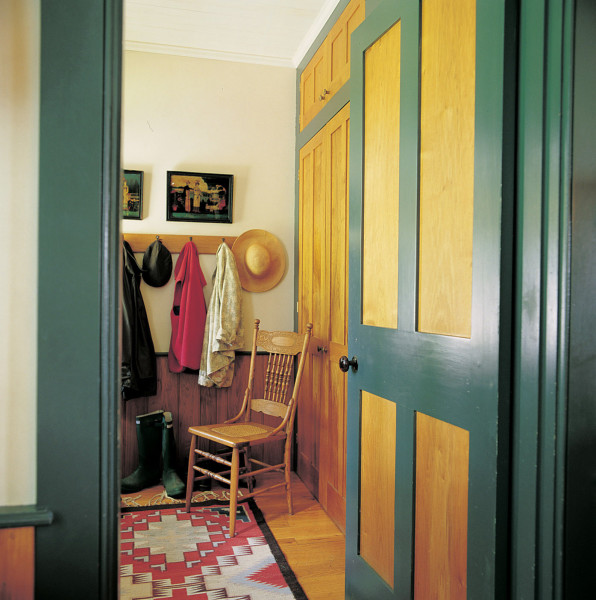
We have much more stuff today, and the modern mudroom often demands as much design attention as the kitchen. Built-in drawers, compartments, and open “lockers” organize everything from shoes, coats, and hats to lacrosse sticks and beach towels.
In an old house, though, the functions of the modern mudroom may be better split up among several different areas. At the entry, provide a bench or seat, a tabletop or shelf, and a few hooks. Store most outerwear in a separate clothes closet nearby. Create a sports center in the basement or garage. Realize that no matter how big and well thought-out, the mudroom can never accommodate all of a family’s daily drop-offs, all of our things and hobbies. Seasonal reorganization is always needed, and probably so is out-of-sight storage.
With beadboard and pegs, this mudroom bench by Crown Point Cabinetry is reminiscent of both Shaker details and those of 19th-century utility spaces. Courtesy of Crown Point Cabinetry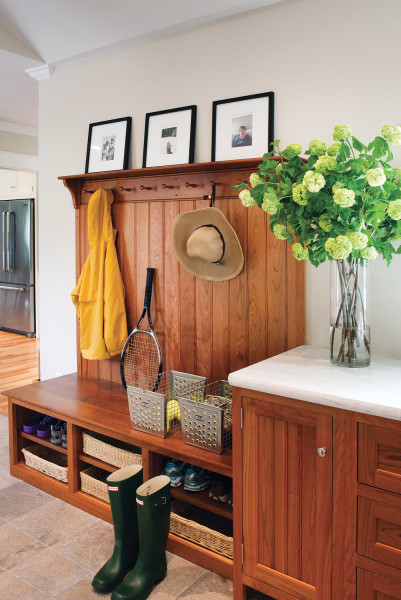
New Hampshire-based designer Amy Mitchell solved the storage problem in her own 1790 house by creating a brick-floored landing space near the kitchen entry, and combining pantry and laundry in a separate room. She calls her mudroom a boot room—the British term for a more unfitted, make-do version. No obsessive organization into custom cubbies here, just an indoor-outdoor floor, clothes pegs, a vintage piece or two, and a closet with doors that hide the rest.
The boot room in a Massachusetts house is an upgrade by Hickox Williams Architects. Eric Roth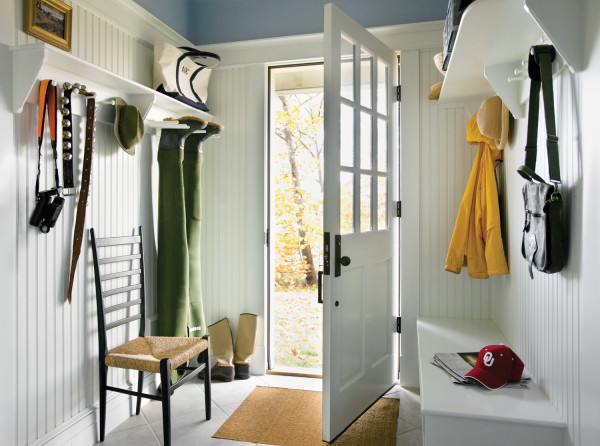
If you have the luxury of designing a separate, good-size mudroom, look to such historical precedents as pantries, built-ins, and even old-fashioned carrels (as in libraries and telephone banks). Simple is better than fussy; adaptable is better than over-specialized. (Those lacrosse sticks too soon are outgrown!)
Flooring might be stone, brick (or brick-look porcelain tile), sealed ceramic tile, or linoleum. Area rugs should be washable and fade-resistant. Lighting is important, if you want to find that matching mitten in the basket—use a mix of overhead, under-cabinet, and task-specific fixtures. Add a small mirror. Other materials and construction details should be cued by those already in the house.
Closets, cupboards, and cabinets
In a closet room by David Heide Design Studio, open wardrobes with period trim flank an operable art-glass window over a period-inspired, built-in dresser. Susan Gilmore for David Heide Design Studio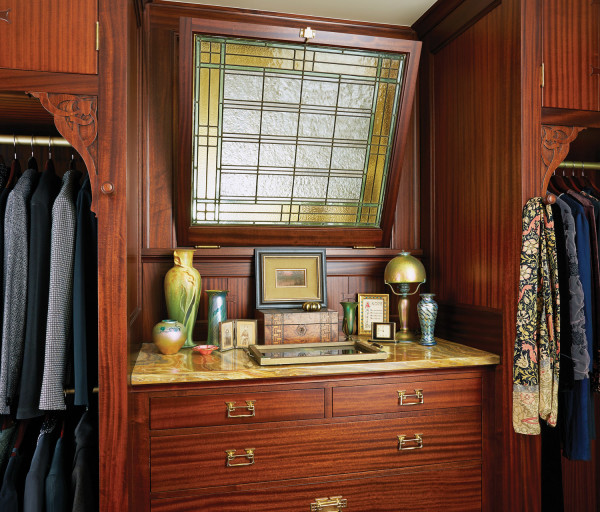
The word “closet” at first meant a small, private room used for meetings or personal care, or to store valuables. Our modern concept of a closet was rare until the late 19th century. People had less stuff, certainly many fewer items of clothing, which was stored in chests, trunks, and clothes presses. An attic room might be devoted to clothes storage. When there is something like a closet in an 18th- or early 19th-century house, it’s more likely in the parlor (where a closed cupboard next to the chimney held liquor) or the dining room (where a corner cabinet displayed china and glassware). A rare example of a clothes closet is in the Chintz Room at Washington’s Mount Vernon. It has shelves and a pegboard; the room otherwise lacks a chest or clothes press.
By 1870, hanging rods followed the invention of the clothes hanger. In 1880, The Dakota apartment building in New York City advertised reach-in clothes closets—hardly walk-ins, yet a luxury for the times. Greene and Greene’s Gamble House of 1908 boasts built-in closets in the master bedroom, complete with a ventilated, pull-down lower cabinet for shoes. After the 1930s, closets became an expected standard. By the 1950s, they were larger, sometimes with sliding or bifold doors. The modern walk-in closet came along in the materialistic 1980s. Since then, we’ve even seen walk-in closets with wet bars.
Illustration of a portière from Harper’s Bazaar magazine, 1881. 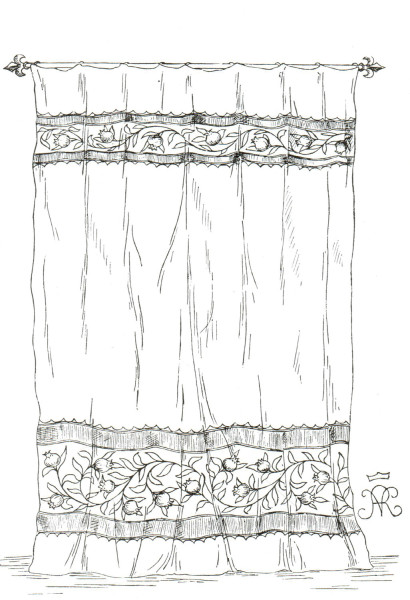
Closet door, or a curtain?
A door hides clutter. It fully blocks UV light that might fade clothing, and it keeps household odors away from clothes. A portière (full-length door curtain) is a good option when a door swing would be awkward or impossible in the space. The portière also adds a decorative element. Hang the curtain from rings on a sturdy rod so that it’s easy to open and close.
A closet wall by Crown Point Cabinetry echoes the organization—and closed doors—of a century-old illustration in a book on housekeeping. Courtesy of Crown Point Cabinetry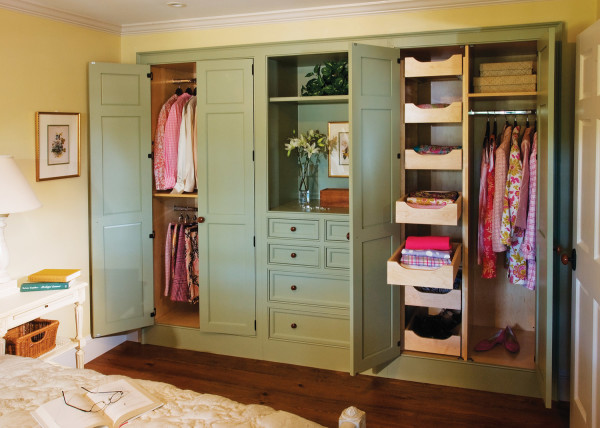
Built-in closets
Today’s large, walk-in closet includes custom storage units and even seating. But a walk-in gobbles up space and is less flexible than options that spread storage around the house. In an old house, of course, such an amenity is possible only if you are adding on, or converting a small bedroom to a closet.
More attractive than a closet, a storage piece by The Kennebec Company takes the form of a kitchen built-in or dining-room cupboard. The center section pulls down to become a serving board. Courtesy Kennebec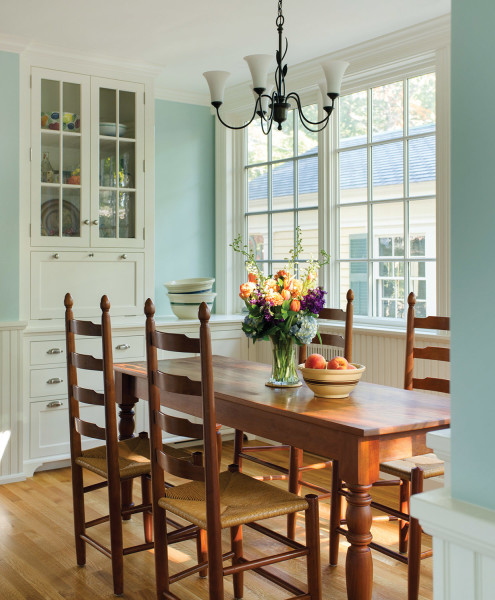
What to do, if you have clutter in the foyer and clothes piled on a bedroom chair? Workable, historical options exist. Besides such discrete spaces as back halls and pantries, look to precedent for both hidden and built-in options. Shoes or linens can be stored, as an example, inside a window seat.
Space hidden & found
Add storage between studs in the wall, in the spandrel area under a staircase, or in knee space under an eave. Any of these can hold built-in drawers or an odd-shaped closet. A clothes closet a mere 30” deep can more than make up for the lost floor space.
A former screen porch, enclosed, is a mudroom now plumbed for the old stone laundry sink. The historical space has bits of of furniture and baskets, rather than built-ins. Gross & Daley Photography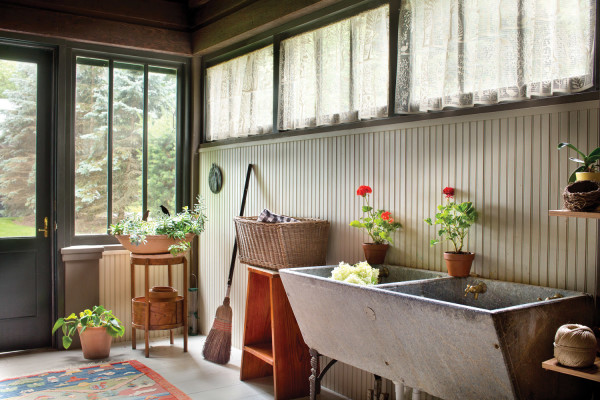
Make it useful above all
In a newly built room, construction details and materials should be cued by those in the rest of the house—albeit more durable and informal. Hardwood stands up well for built-ins; Colonial Revival houses of the early 20th century would have had white enamel paint. Beadboard is a standard wall-cladding material for back-of-house rooms.
Some households find that a utility sink is a critical addition; it comes in handy for gardeners, for renovation cleanup, and to contain the mess of regular housekeeping.
The original mudroom in a rural bungalow is again functional with the addition of an antique baker’s cabinet and a vintage sink. 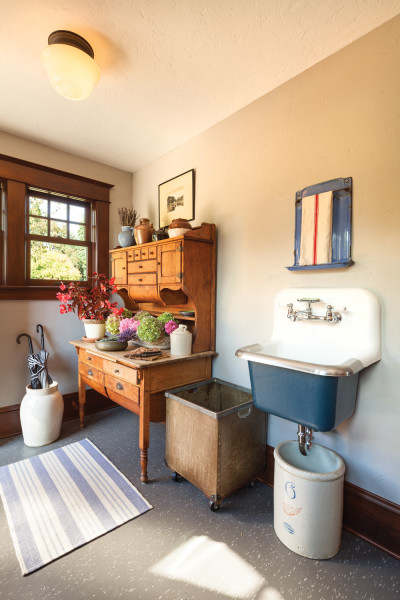
Closets of old cariants offer insight for designing today
- armoire A freestanding piece of furniture for in-use clothing, with doors, behind which you might find shelves or a clothing rod.
- cabinet Once meaning a small, private room, it’s a case with shelves or drawers or both, used for storage.
- chifferobe From chiffonier + wardrobe: a freestanding armoire or wardrobe with a built-in chest of drawers.
- chiffonier A tall, narrow chest of drawers, sometimes fronted by a door.
- cloakroom A room fitted with pegs or hooks for temporary storage of outer garments. Also, a euphemism for a guest bathroom.
- closet The chiefly American word for a closed space or recess with a door, used for storage.
- clothes press An 18th-century word for a cabinet or trunk for storing clothes, especially a tall cabinet with shelves to hold folded items.
- cubby From a word for a stall or pen: one in a group of small, boxlike enclosures open at the front.
- cupboard Once a table for dishware, it came to mean a closed cabinet or wall recess with a door and shelves.
- dresser A chest of drawers, sometimes with a mirror on top, especially one used to store clothing. When used in a dining room, it’s more often called a sideboard.
- locker One of several in a row of compartments used for storage, usually with a lockable door.
- pantry A small room or closet for storage of foodstuffs or dishware.
- trunk room A small storage room, sometimes in the attic, for storing steamer trunks, luggage, and out-of-season clothing. A cedar closet might be included or nearby.
- wardrobe A cabinet specifically designed for clothes, most often with a pole and hangers.
Resources
designers David Heide Design Studio and Hickox Williams Architects
cabinetmakers Crown Point Cabinetry; The Kennebec Company; and NR Hiller Design



